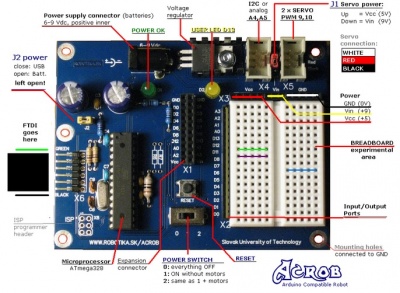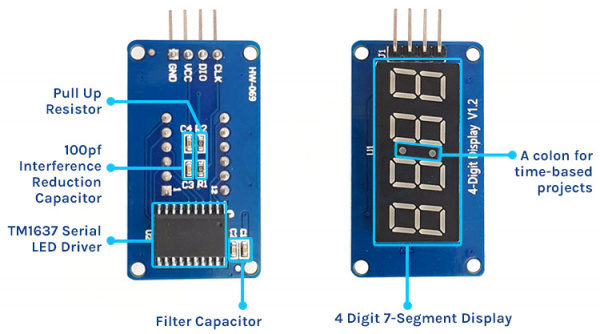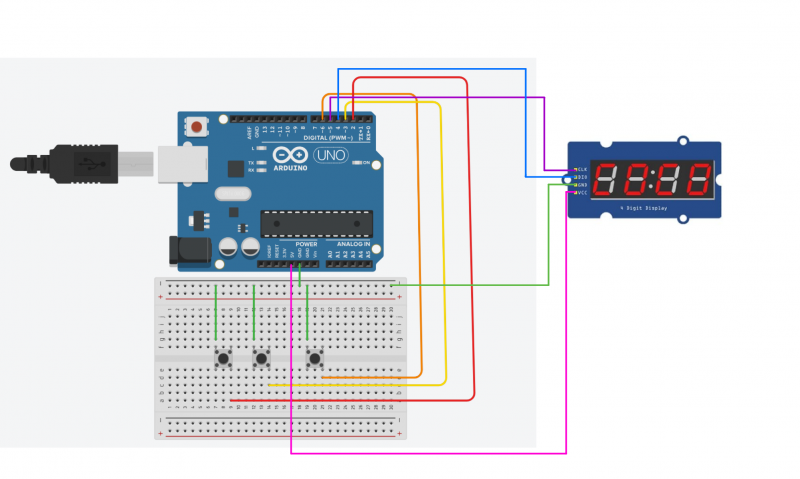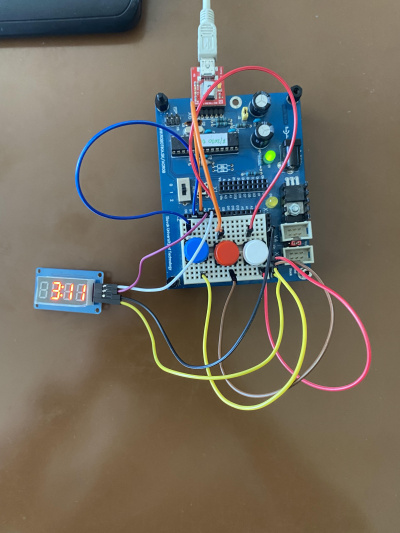7-segmentový displej na futbal: Rozdiel medzi revíziami
Z SensorWiki
(→Algoritmus a program) |
(→Algoritmus a program) |
||
| Riadok 137: | Riadok 137: | ||
} | } | ||
}</source></tab> | }</source></tab> | ||
| + | <tab name="semproj_uart.c"><source lang="c++" style="background: LightYellow;"> | ||
| + | #include <avr/io.h> | ||
| + | #include <util/delay.h> | ||
| + | #include "uart.h" | ||
| + | |||
| + | #define CLK PD5 // CLK -> pin 5 portD.5 | ||
| + | #define DIO PD4 // DIO -> pin 4 portD.4 | ||
| + | |||
| + | #define BIT_DELAY 100 // Delay 100ms | ||
| + | |||
| + | // Define for TM1637 | ||
| + | #define TM1637_I2C_COMM1 0x40 | ||
| + | #define TM1637_I2C_COMM2 0xC0 | ||
| + | #define TM1637_I2C_COMM3 0x80 | ||
| + | |||
| + | // 7-segment display digit mapping | ||
| + | const uint8_t digitToSegment[] = { | ||
| + | // XGFEDCBA | ||
| + | 0b00111111, // 0 | ||
| + | 0b00000110, // 1 | ||
| + | 0b01011011, // 2 | ||
| + | 0b01001111, // 3 | ||
| + | 0b01100110, // 4 | ||
| + | 0b01101101, // 5 | ||
| + | 0b01111101, // 6 | ||
| + | 0b00000111, // 7 | ||
| + | 0b01111111, // 8 | ||
| + | 0b01101111, // 9 | ||
| + | 0b01110111, // A | ||
| + | 0b01111100, // b | ||
| + | 0b00111001, // C | ||
| + | 0b01011110, // d | ||
| + | 0b01111001, // E | ||
| + | 0b01110001 // F | ||
| + | }; | ||
| + | |||
| + | uint8_t brightness = (0x7 & 0x7) | 0x08; | ||
| + | |||
| + | static const uint8_t minusSegments = 0b01000000; | ||
| + | |||
| + | |||
| + | void hw_init( void ) | ||
| + | { | ||
| + | DDRB |= (1<<LED); // PORTB.5 kde je LED ma byt OUTPUT | ||
| + | /* sem si mozete dopisat svoje vlastne inicializacne prikazy */ | ||
| + | } | ||
| + | |||
| + | void uart_init( void ) | ||
| + | { | ||
| + | // for different BAUD rate change the project settings, or uncomment | ||
| + | // following two lines: | ||
| + | // #undef BAUD // avoid compiler warning | ||
| + | // #define BAUD 115200 | ||
| + | |||
| + | #include <util/setbaud.h> // requires defined BAUD | ||
| + | |||
| + | UBRR0H = UBRRH_VALUE; | ||
| + | UBRR0L = UBRRL_VALUE; | ||
| + | #if USE_2X // defined in setbaud.h | ||
| + | UCSR0A |= (1 << U2X0); | ||
| + | #else | ||
| + | UCSR0A &= ~(1 << U2X0); | ||
| + | #endif | ||
| + | |||
| + | |||
| + | UCSR0C = _BV(UCSZ01) | _BV(UCSZ00); /* 8-bit data */ | ||
| + | UCSR0B = _BV(RXEN0) | _BV(TXEN0); /* Enable RX and TX */ | ||
| + | } | ||
| + | |||
| + | |||
| + | int uart_putc( char c, FILE *stream ) | ||
| + | { | ||
| + | if (c == '\n') | ||
| + | uart_putc('\r',stream); | ||
| + | |||
| + | loop_until_bit_is_set(UCSR0A, UDRE0); /* Wait until data register empty. */ | ||
| + | UDR0 = c; | ||
| + | return 0; | ||
| + | } | ||
| + | |||
| + | |||
| + | void uart_puts(const char *s) | ||
| + | { | ||
| + | /* toto je vasa uloha */ | ||
| + | } | ||
| + | |||
| + | char uart_getc(void) | ||
| + | { | ||
| + | loop_until_bit_is_set(UCSR0A, RXC0); /* Wait until data exists. */ | ||
| + | return UDR0; | ||
| + | } | ||
| + | |||
| + | void delay(int delay) // vlastna funkcia pre dlhsie casy | ||
| + | { | ||
| + | for (int i=1; i<=delay; i++) | ||
| + | _delay_ms(1); | ||
| + | } | ||
| + | |||
| + | void comunication_start(){ | ||
| + | set_bit(DDRD, DIO); // Set DIO as output | ||
| + | clear_bit(PORTD, DIO); // Set DIO as output | ||
| + | _delay_us(BIT_DELAY); | ||
| + | } | ||
| + | |||
| + | void comunication_stop(){ | ||
| + | set_bit(DDRD, DIO); // Set DIO as output | ||
| + | clear_bit(PORTD, DIO); // Set DIO as output | ||
| + | _delay_us(BIT_DELAY); | ||
| + | |||
| + | clear_bit(DDRD, CLK); // Set CLK as input | ||
| + | set_bit(PORTD, CLK); // CLK as input pull-up on | ||
| + | _delay_us(BIT_DELAY); | ||
| + | |||
| + | clear_bit(DDRD, DIO); // Set DIO as input | ||
| + | set_bit(PORTD, DIO); // DIO as input pull-up on | ||
| + | _delay_us(BIT_DELAY); | ||
| + | } | ||
| + | |||
| + | |||
| + | void displayShowDots(uint8_t dots, uint8_t* digits){ | ||
| + | for(int i = 0; i < 4; ++i) | ||
| + | { | ||
| + | digits[i] |= (dots & 0x80); | ||
| + | dots <<= 1; | ||
| + | } | ||
| + | } | ||
| + | |||
| + | int inicialize_bit(uint8_t byte){ | ||
| + | uint8_t data = byte; | ||
| + | |||
| + | // 8 Data Bits | ||
| + | for(uint8_t i = 0; i < 8; i++) { | ||
| + | // CLK low | ||
| + | set_bit(DDRD, CLK); | ||
| + | clear_bit(PORTD, CLK); | ||
| + | _delay_us(BIT_DELAY); | ||
| + | |||
| + | // Set data bit | ||
| + | if (data & 0x01){ | ||
| + | clear_bit(DDRD, DIO); // Set DIO as input | ||
| + | set_bit(PORTD, DIO); // DIO as input pull-up on | ||
| + | } else{ | ||
| + | set_bit(DDRD, DIO); // Set DIO as output | ||
| + | clear_bit(PORTD, DIO); // Set DIO low | ||
| + | } | ||
| + | |||
| + | _delay_us(BIT_DELAY); | ||
| + | |||
| + | // CLK high | ||
| + | clear_bit(DDRD, CLK); // Set CLK as input | ||
| + | set_bit(PORTD, CLK); // CLK as input pull-up on | ||
| + | _delay_us(BIT_DELAY); | ||
| + | data = data >> 1; | ||
| + | } | ||
| + | |||
| + | // Wait for acknowledge | ||
| + | // CLK to zero | ||
| + | set_bit(DDRD, CLK); // Set CLK as output | ||
| + | clear_bit(PORTD, CLK); // Set CLK low | ||
| + | |||
| + | clear_bit(DDRD, DIO); // Set DIO as input | ||
| + | set_bit(PORTD, DIO); // DIO as input pull-up on | ||
| + | _delay_us(BIT_DELAY); | ||
| + | |||
| + | // CLK to high | ||
| + | clear_bit(DDRD, CLK); // Set CLK as input | ||
| + | set_bit(PORTD, CLK); // Set CLK high | ||
| + | _delay_us(BIT_DELAY); | ||
| + | uint8_t ack = !bit_is_clear(PIND, DIO); | ||
| + | if (ack == 0) | ||
| + | set_bit(DDRD, DIO); // Set DIO as output | ||
| + | clear_bit(PORTD, DIO); // Set DIO low | ||
| + | |||
| + | _delay_us(BIT_DELAY); | ||
| + | set_bit(DDRD, CLK); // Set CLK as output | ||
| + | clear_bit(PORTD, CLK); // Set CLK low | ||
| + | _delay_us(BIT_DELAY); | ||
| + | |||
| + | return ack; | ||
| + | } | ||
| + | |||
| + | |||
| + | |||
| + | |||
| + | // Function to display a decimal number with custom options | ||
| + | void display_middle_dots(int num, uint8_t dots, const int leading_zero, | ||
| + | uint8_t length, uint8_t pos){ | ||
| + | display_number(num < 0? -10 : 10, num < 0? -num : num, dots, leading_zero, length, pos); | ||
| + | } | ||
| + | |||
| + | // Function to display a number in a given base with custom options | ||
| + | void display_number(int8_t base, uint16_t num, uint8_t dots, const int leading_zero, | ||
| + | uint8_t length, uint8_t pos) | ||
| + | { | ||
| + | int negative = 0; // False | ||
| + | if (base < 0) { | ||
| + | base = -base; | ||
| + | negative = 1; // True | ||
| + | } | ||
| + | |||
| + | uint8_t digits[4]; | ||
| + | |||
| + | if (num == 0 && !leading_zero) { | ||
| + | // Singular case - take care separately | ||
| + | for(uint8_t i = 0; i < (length-1); i++) | ||
| + | digits[i] = 0; | ||
| + | digits[length-1] = digitToSegment[0 & 0x0f];; | ||
| + | } | ||
| + | else { | ||
| + | for(int i = length-1; i >= 0; --i) | ||
| + | { | ||
| + | uint8_t digit = num % base; | ||
| + | |||
| + | if (digit == 0 && num == 0 && leading_zero == 0) | ||
| + | // Leading zero is blank | ||
| + | digits[i] = 0; | ||
| + | else | ||
| + | digits[i] = digitToSegment[digit & 0x0f];; | ||
| + | |||
| + | if (digit == 0 && num == 0 && negative) { | ||
| + | digits[i] = minusSegments; | ||
| + | negative = 0; | ||
| + | } | ||
| + | |||
| + | num /= base; | ||
| + | } | ||
| + | } | ||
| + | |||
| + | if(dots != 0) | ||
| + | { | ||
| + | displayShowDots(dots, digits); | ||
| + | } | ||
| + | |||
| + | set_segments(digits, length, pos); | ||
| + | } | ||
| + | |||
| + | // Function to display a decimal number with default options | ||
| + | void display_number_segment(int num, const int leading_zero, uint8_t length, uint8_t pos){ | ||
| + | display_middle_dots(num, 0x40, leading_zero, length, pos); | ||
| + | } | ||
| + | |||
| + | void set_segments(const uint8_t segments[], uint8_t length, uint8_t pos){ | ||
| + | // Write COMM1 | ||
| + | comunication_start(); | ||
| + | inicialize_bit(TM1637_I2C_COMM1); | ||
| + | comunication_stop(); | ||
| + | |||
| + | // Write COMM2 + first digit address | ||
| + | comunication_start(); | ||
| + | inicialize_bit(TM1637_I2C_COMM2 + (pos & 0x03)); | ||
| + | |||
| + | // Write the data bytes | ||
| + | for (uint8_t k=0; k < length; k++) | ||
| + | inicialize_bit(segments[k]); | ||
| + | |||
| + | comunication_stop(); | ||
| + | |||
| + | // Write COMM3 + brightness | ||
| + | comunication_start(); | ||
| + | inicialize_bit(TM1637_I2C_COMM3 + (brightness & 0x0f)); | ||
| + | comunication_stop(); | ||
| + | } | ||
| + | |||
| + | |||
| + | </source></tab> | ||
</tabs> | </tabs> | ||
Verzia zo dňa a času 12:54, 6. máj 2024
Záverečný projekt predmetu MIPS / LS2024 - Daniel Žula
Zadanie
Pripojenie 7 - segmentového LED displeja k vývojovej doske, vytvorenie potrebných knižníc a funkcií. Cieľom je, aby sme dokázali zobraziť skóre futbalového zápasu, ktoré dokážeme meniť podľa potreby pomocou tlačidiel.
Literatúra:
Analýza a opis riešenia
Princíp fungovania bol jednoduchý, ak stlačíme tlačidlo príslušné k prvému tímu, meníme skóre prvého tímu a ak stlačíme tlačidlo príslušné k druhému tímu, meníme skóre druhého tímu. Takisto máme tlačidlo RESET, ktoré celé skóre resetuje. Na správne fungovanie sme si vytvorili knižnicu, v ktorej sme zadefinovali čísla od 0-9 pomocou zapnutých a vypnutých segmentov na 7 segmentovke.
Algoritmus a program
Tento program sme vytvorili na ovládanie 7 segmentového displeja pomocou tlačidiel a následného zobrazovania futbalového skóre pomocou tlačidiel. Najprv sme si vytvorili knižnicu do ktorej sme uložili čísla od 0-9 na zobrazenie čísiel pomocou svietiacich a zhasnutých segmentov. Následne sme si vytvorili funkcie na zapnutie a vypnutie komunikácie.
Potom sme si vytvorili funkcie na inicializáciu, nastavenie segmentov a ich následné zobrazenie. Nakoniec sme pre INT0 a INT1 spravili funkcie, jedna pre ľavú stranu a druhá pre pravú stranu, v ktorých po stlačení tlačidla nastalo zvýšenie hodnoty o 1, kde ak sme dosiahli číslo 99 a zvýšili sme ho, číslo sa nám resetovalo naspäť na 0, keďže na číselné hodnoty sme mali iba 2 7 - segmentové displeje. Keď sme mali všetky tieto funkcie zadefinované, v hlavnej časti programu sme CLK aj DIO nastavili opäť ako input, povolili sme INT0 a INT1 takisto sei().
Následne vo while funkcii sme už len dané čísla, ktoré boli uložené v counter_left a counter_right zobrazovali pomocou našej funkcie pre zobrazenie čísla na 7 segmentovke, kde sme pozíciu čísel nastavili na pravú 7 segmentovku z dvojice (čiže celkovo 2. a 4. 7 segmentovka) a po zvýšení čísla na 10 a viac sa začali využívať obe 7 segmentové displeje pre daný tím. Po stlačení tlačidla RESET sa hodnoty v counter_left a counter_right vynulovali a opäť sa využívali iba pravé 7 segmentovky z dvojice. Takto to funguje donekonečna.
// Required libraries
#include <avr/io.h>
#include <util/delay.h>
#include <avr/interrupt.h>
#define CLK PD5 // CLK -> pin 5
#define DIO PD4 // DIO -> pin 4
#define set_bit(ADDRESS,BIT) (ADDRESS |= (1<<BIT))
#define clear_bit(ADDRESS,BIT) (ADDRESS &= ~(1<<BIT))
#define LEFT_START_STOP_PIN PD2 // Button for the left team
#define RIGHT_START_STOP_PIN PD3 // Button for the right team
#define RESTART_PIN PD6 // Button for the right team
volatile uint8_t count_left = 0; // Counter for the left displays
volatile uint8_t count_right = 0; // Counter for the right displays
// External interrupt 0 (button for the left team)
ISR (INT0_vect)
{
_delay_ms(10);
if(bit_is_clear(PIND, LEFT_START_STOP_PIN)){
// Increase left count and reset if it reaches 100
count_left++;
if (count_left >= 100) count_left = 0;
}
_delay_ms(150);
}
// External interrupt 1 (button for the right team)
ISR (INT1_vect)
{
_delay_ms(10);
if(bit_is_clear(PIND, RIGHT_START_STOP_PIN)){
// Increase right count and reset if it reaches 100
count_right++;
if (count_right >= 100) count_right = 0;
}
_delay_ms(150);
}
int main(void){
clear_bit(DDRD, CLK); // Set CLK as input
set_bit(PORTD, CLK); // CLK as input pull-up on
clear_bit(DDRD, DIO); // Set DIO as input
set_bit(PORTD, DIO); // DIO as input pull-up o
clear_bit(DDRD, LEFT_START_STOP_PIN); // Set LEFT_START_STOP_PIN as input
set_bit(PORTD, LEFT_START_STOP_PIN); // LEFT_START_STOP_PIN as input pull-up on
clear_bit(DDRD, RIGHT_START_STOP_PIN); // Set RIGHT_START_STOP_PIN as input
set_bit(PORTD, RIGHT_START_STOP_PIN); // RIGHT_START_STOP_PIN as input pull-up on
clear_bit(DDRD, RESTART_PIN); // set RESET_PIN as input
set_bit(PORTD, RESTART_PIN); // RESET_PIN as input pull-up on
uint8_t data[] = { 0, 0, 0, 0 };
set_segments(data, 4, 0);
EIMSK = 0b00000011; // Enable INT0, INT1
EICRA = 0b00001010; // Detect falling edge on both pins
sei(); // Enable interrupts
while (1) {
if (bit_is_clear(PIND, RESTART_PIN)) {
// Perform reset operation
count_left = 0; // Reset the left count
count_right = 0; // Reset the right count
}
// Display left count on left two displays and right count on right two displays
display_number_segment(count_right, 0, 2, 2);
display_number_segment(count_left, 0, 2, 0);
}
return 0;
}
}
#include <avr/io.h>
#include <util/delay.h>
#include "uart.h"
#define CLK PD5 // CLK -> pin 5 portD.5
#define DIO PD4 // DIO -> pin 4 portD.4
#define BIT_DELAY 100 // Delay 100ms
// Define for TM1637
#define TM1637_I2C_COMM1 0x40
#define TM1637_I2C_COMM2 0xC0
#define TM1637_I2C_COMM3 0x80
// 7-segment display digit mapping
const uint8_t digitToSegment[] = {
// XGFEDCBA
0b00111111, // 0
0b00000110, // 1
0b01011011, // 2
0b01001111, // 3
0b01100110, // 4
0b01101101, // 5
0b01111101, // 6
0b00000111, // 7
0b01111111, // 8
0b01101111, // 9
0b01110111, // A
0b01111100, // b
0b00111001, // C
0b01011110, // d
0b01111001, // E
0b01110001 // F
};
uint8_t brightness = (0x7 & 0x7) | 0x08;
static const uint8_t minusSegments = 0b01000000;
void hw_init( void )
{
DDRB |= (1<<LED); // PORTB.5 kde je LED ma byt OUTPUT
/* sem si mozete dopisat svoje vlastne inicializacne prikazy */
}
void uart_init( void )
{
// for different BAUD rate change the project settings, or uncomment
// following two lines:
// #undef BAUD // avoid compiler warning
// #define BAUD 115200
#include <util/setbaud.h> // requires defined BAUD
UBRR0H = UBRRH_VALUE;
UBRR0L = UBRRL_VALUE;
#if USE_2X // defined in setbaud.h
UCSR0A |= (1 << U2X0);
#else
UCSR0A &= ~(1 << U2X0);
#endif
UCSR0C = _BV(UCSZ01) | _BV(UCSZ00); /* 8-bit data */
UCSR0B = _BV(RXEN0) | _BV(TXEN0); /* Enable RX and TX */
}
int uart_putc( char c, FILE *stream )
{
if (c == '\n')
uart_putc('\r',stream);
loop_until_bit_is_set(UCSR0A, UDRE0); /* Wait until data register empty. */
UDR0 = c;
return 0;
}
void uart_puts(const char *s)
{
/* toto je vasa uloha */
}
char uart_getc(void)
{
loop_until_bit_is_set(UCSR0A, RXC0); /* Wait until data exists. */
return UDR0;
}
void delay(int delay) // vlastna funkcia pre dlhsie casy
{
for (int i=1; i<=delay; i++)
_delay_ms(1);
}
void comunication_start(){
set_bit(DDRD, DIO); // Set DIO as output
clear_bit(PORTD, DIO); // Set DIO as output
_delay_us(BIT_DELAY);
}
void comunication_stop(){
set_bit(DDRD, DIO); // Set DIO as output
clear_bit(PORTD, DIO); // Set DIO as output
_delay_us(BIT_DELAY);
clear_bit(DDRD, CLK); // Set CLK as input
set_bit(PORTD, CLK); // CLK as input pull-up on
_delay_us(BIT_DELAY);
clear_bit(DDRD, DIO); // Set DIO as input
set_bit(PORTD, DIO); // DIO as input pull-up on
_delay_us(BIT_DELAY);
}
void displayShowDots(uint8_t dots, uint8_t* digits){
for(int i = 0; i < 4; ++i)
{
digits[i] |= (dots & 0x80);
dots <<= 1;
}
}
int inicialize_bit(uint8_t byte){
uint8_t data = byte;
// 8 Data Bits
for(uint8_t i = 0; i < 8; i++) {
// CLK low
set_bit(DDRD, CLK);
clear_bit(PORTD, CLK);
_delay_us(BIT_DELAY);
// Set data bit
if (data & 0x01){
clear_bit(DDRD, DIO); // Set DIO as input
set_bit(PORTD, DIO); // DIO as input pull-up on
} else{
set_bit(DDRD, DIO); // Set DIO as output
clear_bit(PORTD, DIO); // Set DIO low
}
_delay_us(BIT_DELAY);
// CLK high
clear_bit(DDRD, CLK); // Set CLK as input
set_bit(PORTD, CLK); // CLK as input pull-up on
_delay_us(BIT_DELAY);
data = data >> 1;
}
// Wait for acknowledge
// CLK to zero
set_bit(DDRD, CLK); // Set CLK as output
clear_bit(PORTD, CLK); // Set CLK low
clear_bit(DDRD, DIO); // Set DIO as input
set_bit(PORTD, DIO); // DIO as input pull-up on
_delay_us(BIT_DELAY);
// CLK to high
clear_bit(DDRD, CLK); // Set CLK as input
set_bit(PORTD, CLK); // Set CLK high
_delay_us(BIT_DELAY);
uint8_t ack = !bit_is_clear(PIND, DIO);
if (ack == 0)
set_bit(DDRD, DIO); // Set DIO as output
clear_bit(PORTD, DIO); // Set DIO low
_delay_us(BIT_DELAY);
set_bit(DDRD, CLK); // Set CLK as output
clear_bit(PORTD, CLK); // Set CLK low
_delay_us(BIT_DELAY);
return ack;
}
// Function to display a decimal number with custom options
void display_middle_dots(int num, uint8_t dots, const int leading_zero,
uint8_t length, uint8_t pos){
display_number(num < 0? -10 : 10, num < 0? -num : num, dots, leading_zero, length, pos);
}
// Function to display a number in a given base with custom options
void display_number(int8_t base, uint16_t num, uint8_t dots, const int leading_zero,
uint8_t length, uint8_t pos)
{
int negative = 0; // False
if (base < 0) {
base = -base;
negative = 1; // True
}
uint8_t digits[4];
if (num == 0 && !leading_zero) {
// Singular case - take care separately
for(uint8_t i = 0; i < (length-1); i++)
digits[i] = 0;
digits[length-1] = digitToSegment[0 & 0x0f];;
}
else {
for(int i = length-1; i >= 0; --i)
{
uint8_t digit = num % base;
if (digit == 0 && num == 0 && leading_zero == 0)
// Leading zero is blank
digits[i] = 0;
else
digits[i] = digitToSegment[digit & 0x0f];;
if (digit == 0 && num == 0 && negative) {
digits[i] = minusSegments;
negative = 0;
}
num /= base;
}
}
if(dots != 0)
{
displayShowDots(dots, digits);
}
set_segments(digits, length, pos);
}
// Function to display a decimal number with default options
void display_number_segment(int num, const int leading_zero, uint8_t length, uint8_t pos){
display_middle_dots(num, 0x40, leading_zero, length, pos);
}
void set_segments(const uint8_t segments[], uint8_t length, uint8_t pos){
// Write COMM1
comunication_start();
inicialize_bit(TM1637_I2C_COMM1);
comunication_stop();
// Write COMM2 + first digit address
comunication_start();
inicialize_bit(TM1637_I2C_COMM2 + (pos & 0x03));
// Write the data bytes
for (uint8_t k=0; k < length; k++)
inicialize_bit(segments[k]);
comunication_stop();
// Write COMM3 + brightness
comunication_start();
inicialize_bit(TM1637_I2C_COMM3 + (brightness & 0x0f));
comunication_stop();
}
Zdrojový kód: zdrojaky.zip
Overenie
Na zobrazovanie aktuálneho skóre používame dve tlačidlá, jedným, ktorý je vľavo meníme skóre tímu vľavo, a druhým, ktorý je v strede meníme skóre tímu ktorý je napravo, posledným tlačidlom ktoré je vpravo skóre resetujeme.
Video:



